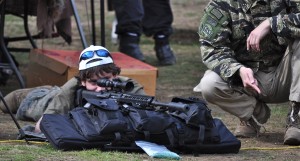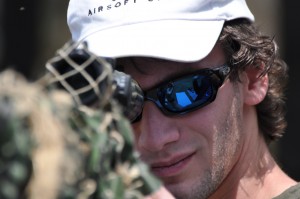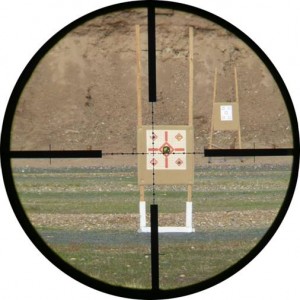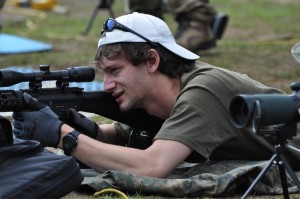
Since I started my Airsoft career in the 2006 season, the NEASG Sniper Qualification has been something of a myth to my teammates and me. We’d never met anyone who was sniper certified and had never even seen official literature or heard official word on what it entailed or what privileges it granted. My understanding of the mythical Sniper Certification was that it granted a player the ability to wear a Ghillie suit and use a weapon firing at 2.8J, while restricting the player’s minimum engagement distance (MED) to 100ft. As it turns out, I was spot on.Over the winter, my friend Andrew ‘Gentleman’ Martin and I had spoken of building a designated marksman rifle (DMR)/sniper weapon system (SWS) for this season, using a KWA M16 SR12 as a base rifle. I figured we could push over 100yds of effective range if we could fire at 2.8J, so we decided to build the rifle and get sniper certified so we could field it. Come Spring, we have the new SR12 running well (but still in need of more) and after a bunch of confusion as to when to course would be, we finally made it to the NEASG Sniper Qualification Course at Feel Good Farm.
The course was to take place over the usual FGF time frame. Show up at 9, start at 10, break for lunch, then end at 5pm. When Gentleman and I showed up, we were the first. Cobalt (a NEASG staff member, and respected member of the New England airsoft community), the instructor, and the instructor’s assistant were there with us and we walked over to chat while we waited for the other sniper students to show up. While we were standing around Larry, the field owner, came over and started talking to us. The subject of range estimation came up because Cobalt and our instructors had set out stakes at 50ft intervals in the parking lot. Larry then taught Gentleman and I to learn the length of our stride, so that we can define a range without instruments, and then use that range to help learn accurate estimating. It was very effective. I learned that my stride is almost exactly 3ft, and was able to estimate range to an object, then test my accuracy by pacing the distance to the target. A skill I will be sure to use in future.

The students filtered in and it quickly became evident that Skinny and Pale Rider (both members of team STARK) were the only other students with the realistic budget to be getting into sniping. Any highly effective airsoft weapon system requires a good amount of money to build. One would be hard pressed to set up an effective SWS for less than $500, and the SR12 I built for Gentleman will top $1500 when complete. Other than Skinny, Pale Rider, Gentleman, and me, the other four students clearly were the type of airsofter that might understand that an expensive system is needed to accomplish goals, but they clearly didn’t have the means. As it turned out, only one of them even had the skill.
The course started with a classroom session, which lasted about 4 hours. The instructor, a former real-world special operations sniper who goes by ‘BadKarma6’, was clearly knowledgeable but was also clearly full of himself. He kept branching off onto war stories and topics pertaining only to real steel firearms in a bid to inflate himself as an expert. What really decimated my respect for him as a credible technical instructor was when he tried explaining, with horrific logic and no scientific backup, why heavier bbs don’t hit with enough punch to be used. If he had any understanding of airsoft ballistics, he would know that a heavier bb always hits with more stored energy and resists wind push.

During the classroom section, safety was a big focus, as was the concept that a sniper’s primary job is reconnaissance, not shooting. I was already familiar with all of this, but Cobalt did a good job reenforcing it with some recalling of scenarios played out at major operations and national events. The one highly applicable skills I learned, which I previously didn’t know existed, was Mil Dot range estimation. This is the science of estimating range, utilizing the size of a known object at range the MOA dots on your scope’s cross hairs. What you do is zoom your scope or sight out to its lowest magnification. You then look at your target, which we will say for this example is a standing man. You can estimate based on facts that you know and looking at the man in his environment that he is 6ft, or 2yds, tall. You take that 2 and multiply by 1000 to get 2000. You then divide by the number of Mil Dot spacings covered by the man. Lets say the man is 5 Mil Dot spacings from head to toe. That gives you 400. He is 400 yards away. While 400 yards is far outside of the effective range of an airsoft gun, it does allow for long range recon of a target by a sniper/recon element. A very useful skill that I will certainly apply in the future.
As we came to the live-fire portion of the course, it started raining heavily. Due to the fact that a rain drop can deflect an airsoft bb, we had to wait out the rain before beginning live-fire. After about 30 minutes under the field tent, the rain stopped and everyone got on their rifles to practice zeroing. We started by shooting at targets at 50ft and zeroing our scopes for that range. Within 15 minutes, Gentleman and I had the SR12 drilling a hole smaller than 1 inch. As we and other groups got our rifles zeroed, our targets were moved out to 100ft. Again, Gentleman and I were drilling targets, while the other people on the range sat fumbling with their bolt action spring rifles, trying to get them to shoot straight. The simple fact of the matter was that Gentleman and I had brought the most effective weapon system and the largest amount of talent. That isn’t to say that the other shooters at the qualification couldn’t get better, but we were clearly more experienced with accurate long-range shooting.
There were then two live-fire tests. At 100ft, each cardboard box (being used as a target base) was dressed with a 6″, 2″, and 1″ orange target. We were allowed 5 shots at each target. Hits to the 6″ were worth 1 point. Hits to the 2″ were worth 2 points. Hits to the 1 inch were worth 3 points. With Gentleman spotting for me and calling my wind, I started by landing 5 of 5 on the 6 inch target. I then had a few bad calls regarding wind on the 2 inch target and only landed one. Knowing I’m the best shooter that was at the qualification, I was worried I wouldn’t score the highest on the practical. When I moved my sight to the 1 inch target, I really took my time. It probably took me 10 minutes to fire all 5 rounds at the 1 inch target, as I had to wait for the perfect lull in the wind. I landed 3 of 5 on target, bringing my total store to 16. The highest score after mine was 13, followed by 11, then a number in the single digit scores. I had won Top Shot at sniper qualification and was awarded a bag of ammo as a prize. Not bad, since the bag nearly paid for the price of the qualification.

It felt good ending the day with new skills and having definitively demonstrated that Gentleman and I were the most capable snipers on the field. I’m looking forward to finishing the SR12 and getting even more effective range out of it.
